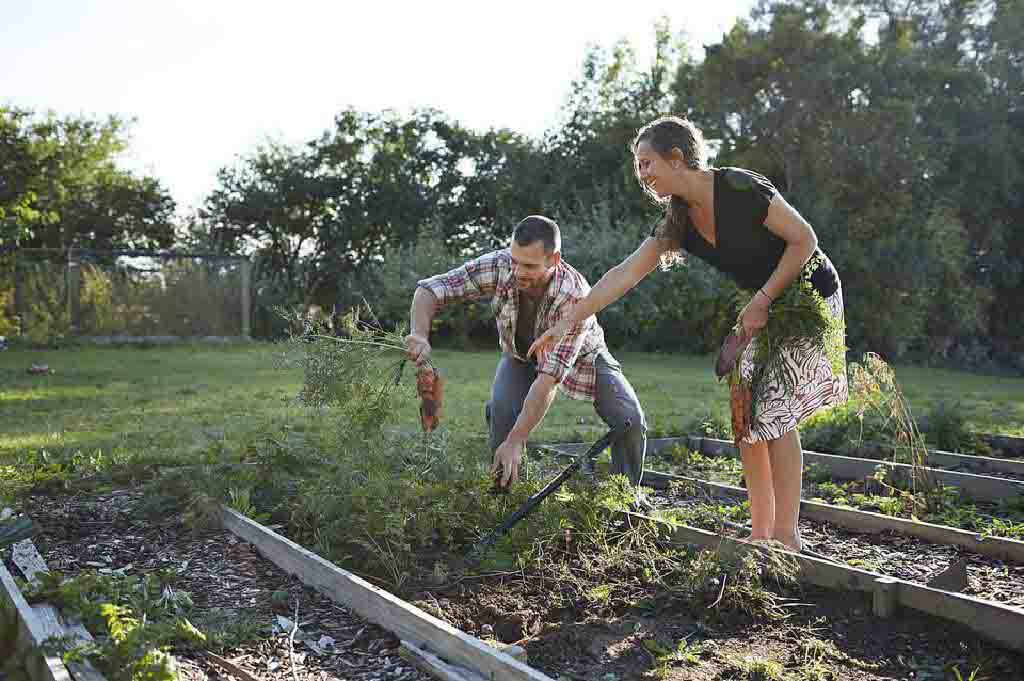How to start a home garden
Written by Joy
Dec 11 2020

How to start a home garden? Although vegetable gardening itself is a fairly simple and enjoyable activity, creating an initial garden requires some work. It's worth it, fortunately it only needs to be done once. Before you start digging, you'd better be sure to think about how to start a home garden.

A sharp flat shovel can be used to cut out the turf. If the soil is poor and needs to be modified with organic matter or other nutrients, then removing the turf may be your best choice.
If your soil of your home garden is in good condition, you can leave the grass in place and build on it. You'd better put a thick layer of newspaper (8-10 sheets) on the garden bed and moisten it thoroughly. Then cover the newspaper with 4-6 inches of soil. The newspaper will eventually decompose, and the turf and weeds will be suffocated. There may be some provocative weeds, but not so many, you can weed them. There is more about the layered method of gradually creating a garden in this new home garden.
Starting with good soil means you don't have to add a lot of artificial fertilizer to your garden. If you feed the soil in a modified way, the soil will feed your plants.
Advantages: Neatly planted, well-ventilated, easy to weed, easy to harvest.
Disadvantages: Single-row plants take up more space than wide-row plants. Floppy plants, like peas, need to be latticed.
Advantages: Wide rows allow more plants to enter a smaller space. There are no spaces and paths between, and you can have 6 times more vegetables in a row than in a traditional single row. Wide lines serve as their own covering. They shelter the weeds, keep the soil the most, and require less watering.
Disadvantages: Not all crops are suitable for wide rows. If it is not crowded, long and long crops like tomatoes and eggplants will yield better. In areas with high humidity and the problems that come with it, squeezing plants into dense rows may exacerbate these problems.
Pros: The raised bed means you will never walk on the planting soil, so it will never be compacted. (To walk in a wide square, temporarily lower the plank to spread the weight and avoid compaction.)
When the garden rotates, it is very convenient to divide the home garden into compartments. If you choose to grow perennial crops, such as asparagus and rhubarb, you can make a bed for them so that you will not be disturbed while you are farming. The soil in the elevated bed drains better than the horizontal soil, and the temperature is faster in spring.
Disadvantages: Sifang family gardens are semi-permanent structures, so if you plan to move or expand your garden, they will work more. Some people don't like the formal symmetry of the Sifang Garden.
Advantages: This style can be very decorative, and you will be surprised how much you can place in the garden without orders. You will attract more pollinators, and beneficial insects and varieties and flowers and pests may not notice that their favorite crops interact with other crops.
Cons: An eclectic home garden can be difficult to maintain. Without an exact path, it is difficult to know what weeds are, let alone remove weeds. Harvesting is also very difficult when starting a home garden.

1. How big should your home garden be?
The first suggestion is to start with a small home garden. Unless you like to eat space creatures such as corn, you can start with a manageable size garden. 12 X 20 should give you plenty of variety. Vegetables will not wait when it is convenient for you.2. Exploring the work of a real home garden
You could measure and mark out your garden space on the lawn. Now it is very hard to make a new garden. Did you remove the turf or build it on top? This is not people's favorite home garden chore, but there is no way to avoid it. The land you choose may contain grass or at least weeds. Before you plant anything, these must be removed somehow. Plowing is best done in autumn without weeding or weeding, so that the grass has a chance to start to decompose in winter. Even so, you may see new grass and weeds in spring.A sharp flat shovel can be used to cut out the turf. If the soil is poor and needs to be modified with organic matter or other nutrients, then removing the turf may be your best choice.
If your soil of your home garden is in good condition, you can leave the grass in place and build on it. You'd better put a thick layer of newspaper (8-10 sheets) on the garden bed and moisten it thoroughly. Then cover the newspaper with 4-6 inches of soil. The newspaper will eventually decompose, and the turf and weeds will be suffocated. There may be some provocative weeds, but not so many, you can weed them. There is more about the layered method of gradually creating a garden in this new home garden.
Starting with good soil means you don't have to add a lot of artificial fertilizer to your garden. If you feed the soil in a modified way, the soil will feed your plants.
3. Make a home garden plan
How to develop the actual layout of plants is entirely a matter of preference. Each style has its advantages and disadvantages.Advantages: Neatly planted, well-ventilated, easy to weed, easy to harvest.
Disadvantages: Single-row plants take up more space than wide-row plants. Floppy plants, like peas, need to be latticed.
Wide line
Wide rows are when you grow long pieces of the same vegetables. The wide lines should not be too wide to fit comfortably into their center from the sides. A four-foot wide row is good for most people.Advantages: Wide rows allow more plants to enter a smaller space. There are no spaces and paths between, and you can have 6 times more vegetables in a row than in a traditional single row. Wide lines serve as their own covering. They shelter the weeds, keep the soil the most, and require less watering.
Disadvantages: Not all crops are suitable for wide rows. If it is not crowded, long and long crops like tomatoes and eggplants will yield better. In areas with high humidity and the problems that come with it, squeezing plants into dense rows may exacerbate these problems.
Square
The Pennsylvania Germans believed that this home garden layout was proposed and it is returning to popularity. A square means that the garden is divided into four equal parts with narrow paths in between. The bed itself is usually raised slightly. Although it is best to treat them as four-square squares, they can be divided into any number to make the garden easier to maintain.Pros: The raised bed means you will never walk on the planting soil, so it will never be compacted. (To walk in a wide square, temporarily lower the plank to spread the weight and avoid compaction.)
When the garden rotates, it is very convenient to divide the home garden into compartments. If you choose to grow perennial crops, such as asparagus and rhubarb, you can make a bed for them so that you will not be disturbed while you are farming. The soil in the elevated bed drains better than the horizontal soil, and the temperature is faster in spring.
Disadvantages: Sifang family gardens are semi-permanent structures, so if you plan to move or expand your garden, they will work more. Some people don't like the formal symmetry of the Sifang Garden.
Compromise
Eclecticism adopts various styles. The main mention here is the free-form companion planting style of your home garden, which is more similar to a cottage garden than a home garden, where there are pepper plants and there.Advantages: This style can be very decorative, and you will be surprised how much you can place in the garden without orders. You will attract more pollinators, and beneficial insects and varieties and flowers and pests may not notice that their favorite crops interact with other crops.
Cons: An eclectic home garden can be difficult to maintain. Without an exact path, it is difficult to know what weeds are, let alone remove weeds. Harvesting is also very difficult when starting a home garden.
Latest Updated
- Benefits of Bugleweed - 7 Science-backed Health Benefits
- Bugleweed Dangers & Side Effects - Is It Poisonous?
- How to Plant Evergreen Trees - What You Should Know
- When to Plant Evergreens - Grow Guide for Evergreen Trees
- 12 Wonderful Evergreen Shrubs for Your Garden
- 12 Popular Evergreen Plants with Pictures for Beginners
- When And How To Prune A Lilac Bush Like a Pro
- How to Grow & Care for Lilac Vine (Hardenbergia Violacea)
- Japanese Lilac Tree (Syringa Reticulata) Care & Propagation Guide
- Shumard Oak Pros and Cons - What to Know
Popular Articles
- Winter maintenance of Antirrhinum Majus
- How to Grow Terminalia Mantaly Tree
- How to Grow and Care for Crossostephium Chinense
- How to grow Antirrhinum Majus in spring
- Peristeria Elata (Dove Orchid) Profile: Info & Care Guide
- Underwatered Snake Plant (Sansevieria Trifasciata) - Signs And How To Fix
- How to Care for Brazilian Jasmine Plant (Mandevilla Sanderi)
- How to Grow & Care for Graptopetalum Purple Delight in Summer
- Rosa Chinensis (China Rose): Plant Growing & Care Tips
- How to Care for Baby Sun Rose (Aptenia Cordifolia)